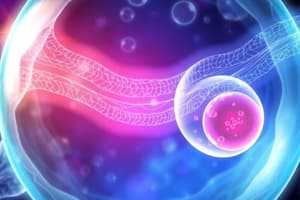Podcast
Questions and Answers
What is the process of formation and development of the embryo called?
What is the process of formation and development of the embryo called?
What is the term for a haploid cell that develops into an egg?
What is the term for a haploid cell that develops into an egg?
What is the function of the Corpus Luteum?
What is the function of the Corpus Luteum?
What is the term for the process of sperm entering the egg?
What is the term for the process of sperm entering the egg?
Signup and view all the answers
What is the name for the first menstruation when a mature egg is released from the ovary?
What is the name for the first menstruation when a mature egg is released from the ovary?
Signup and view all the answers
What is the term for the outermost layer of the blastocyst that later contributes to the placenta?
What is the term for the outermost layer of the blastocyst that later contributes to the placenta?
Signup and view all the answers
What is the term for the process of the formation of male and female gametes?
What is the term for the process of the formation of male and female gametes?
Signup and view all the answers
What is the name of the layer that produces progesterone and leads to the formation of the placenta?
What is the name of the layer that produces progesterone and leads to the formation of the placenta?
Signup and view all the answers
Which layer disappears as the implantation begins in the uterine mucosa?
Which layer disappears as the implantation begins in the uterine mucosa?
Signup and view all the answers
What structure protects the embryo from injury and contains the amniotic fluid?
What structure protects the embryo from injury and contains the amniotic fluid?
Signup and view all the answers
From which layer does the notochord form?
From which layer does the notochord form?
Signup and view all the answers
Which cells give rise to angiogenic cells and flatten to form the blood vessels?
Which cells give rise to angiogenic cells and flatten to form the blood vessels?
Signup and view all the answers
Which layer accumulates fibrin at the end of the first week and forms the mountaine through blastocyst?
Which layer accumulates fibrin at the end of the first week and forms the mountaine through blastocyst?
Signup and view all the answers
Which cells penetrate the uterine mucosa as implantation begins?
Which cells penetrate the uterine mucosa as implantation begins?
Signup and view all the answers
Study Notes
Embryonic Development
- The process of formation and development of the embryo is called embryogenesis.
Gamete Development
- A haploid cell that develops into an egg is called an oocyte.
- The term for the process of formation of male and female gametes is gametogenesis.
Hormonal Regulation
- The Corpus Luteum produces progesterone, which leads to the formation of the placenta.
- The layer that produces progesterone and leads to the formation of the placenta is the syncytiotrophoblast.
Fertilization
- The process of sperm entering the egg is called fertilization.
Menstrual Cycle
- The first menstruation, when a mature egg is released from the ovary, is called menarche.
Blastocyst Development
- The outermost layer of the blastocyst that later contributes to the placenta is the trophoblast.
- The syncytiotrophoblast is the layer that accumulates fibrin at the end of the first week and forms the mound through blastocyst.
Implantation
- As implantation begins in the uterine mucosa, the syncytiotrophoblast layer disappears.
- The cells that penetrate the uterine mucosa as implantation begins are the trophoblastic cells.
Embryo Protection
- The structure that protects the embryo from injury and contains the amniotic fluid is the amnion.
Notochord Formation
- The notochord forms from the mesoderm layer.
Angiogenesis
- The cells that give rise to angiogenic cells and flatten to form the blood vessels are the mesodermal cells.
Studying That Suits You
Use AI to generate personalized quizzes and flashcards to suit your learning preferences.
Related Documents
Description
Test your knowledge of embryogenesis and gametogenesis with this quiz. Explore the process of organ formation, cell development, and the formation of mature egg and sperm cells.




